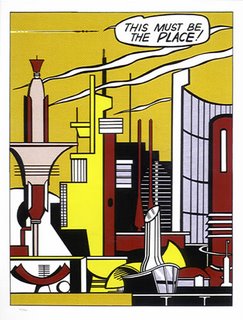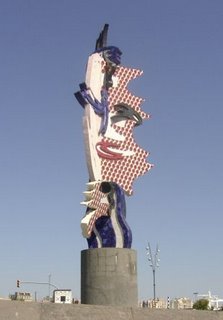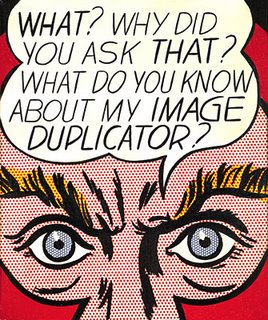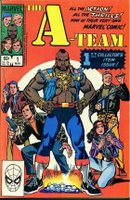
When you make your living cutting brand new worlds whole cloth from your personal mental firmament, it takes a special kind of writer to splatter those brain children over twenty-odd pages of cheap newsprint on a regular basis. For those few writers that have the talent and the creativity, the rewards are minimal, so you'd better love what you're doing. In the minuscule litany of those who love writing comics, there are even fewer who stand out as supernova bright as Brian K. Vaughn.
Brian is the scribe responsible for Ex-Machina, which blows the doors off The Watchmen as an attempt to portray superheroes in a real world setting. His teen superhero series Runaways, offers a fresh and infinitely interesting spin on what it takes to be a hero, even as it blurs the lines between good guys and bad guys. His science fiction series Y The Last Man is a twisting journey of self discovery that pulls equal bits from Stephen King's The Stand and James Tiptree Jr.'s The Screwfly Solution, and beats them both in the grand smackdown of post apocalyptic speculative fiction.
So, it's no wonder that his stand alone graphic novel Pride Of Baghdad, which seemed like kind of a stupid idea on the surface, turned out so remarkably good. The high concept genesis of this little gem started its life as a news report about a quartet of lions that escaped from the Baghdad Zoo during the U.S.'s 2003 bombing of Iraq. Starving, frightened out of their minds, and half dead from exhaustion and exposure, the U.S. Army mercifully put them down. The twist on this is that the story is told from the lions' points of view.
I'm always wary of anthropomorphising animals. If taken too far you get extremist terrorist organizations like P.E.T.A. and its hyperviolent sock puppet A.L.F., or you get regurgitated pablum like Barney the dinosaur, and stupid people with too much money and way too much time on their hands who like to dress their pets up in leather bomber jackets and Harley Davidson paraphernalia. If done right though, you get fine religious allegory like Richard Adams' Watership Down and Neil Gaiman's Dream of a Thousand Cats, or a masterful deconstruction of the nature of revolution like George Orwell's Animal Farm.
Under less skilled hands this story could easily have turned into just another political screed about how bad the United States is and how the evil American Military cold-bloodedly gunned down four poor defenseless animals. It's not. Instead, Pride of Baghdad is a well crafted, impeccably told tale that is entertaining, poignant and tragic.
As a story, Pride of Baghdad works and works well. Brian walks the lions through the wreckage of Baghdad, and the Pride keeps a running commentary that explores heavy ideas like what happens to the civilians during a war, what is the price of freedom, and what happens when your caregivers suddenly go away.
The part that resonated most with me, was a scene where the lions come across a turtle and he recounts the ecological disaster that the Hussien government unleashed during Operation Desert Storm. I was in Saudi Arabia as part of that operation, and I can tell you that the turtle in this story doesn't even scratch the surface of the devastation that occurred outside the Iraqi and Kuwaiti oil fields.
But that's what I like about this story. Brian doesn't browbeat you with the obvious, nor does he ever give in to what was quite possibly the overwhelming urge to preach about how bad war is. We're reading the story, we get it, war is bad. He leaves it at that, preferring instead to concentrate on giving us believable characters and a great story.
The other half of Pride's creative team, Nico Henricson is relatively new to American comics. His first graphic novel, Barnum, was well drafted, if a bit stiff. With Pride of Bagdhad he pulls out all the stops. There are no humans to speak of in this tale, but they're not missed. Nico gives each of the animal characters a wide range of expression and movement that does bring out human qualities in them. This would detract from the realistic feel of the story, but Nico keeps the lions true enough to the source material that they are still believable as animals.
The backgrounds and landscape of Pride are phenomenal. Nico is a master of stylized detail and it's on full display in these pages. He gives us a guided tour of a little slice of hell on earth, and we come away the better for it.
There's no colorist credited, so it's a pretty safe bet that the color choices are Nico's. He applies a bit of a fade to the dull browns and oranges in the outside scenes, which gives the story an effect that recalls some of Ridley Scott's lensing choices during Black Hawk Down. It's a great effect that applies a sort of haze of war. It evokes a feeling of unease that keeps the idea that there is danger around every corner, just at the back of your mind where it should be for this type of story.
Pride of Bagdhad is solid work by a team that meshes well. It's an intense, sad story that is intelligent, relevant, and superbly drawn. It's a short film on paper that's worthy of an Oscar, or in this case an Eisner. Pick it up and give it a try. You will absolutely not be disappointed.

I'll admit this right up front. Roy Lichtenstein was not my favorite artist. It never set right with me that he didn't credit the original artists whose work he was using, and I always found his line work far inferior to the original comics panels he was using. Still and all, his artwork was unique and over the years, I have found several of his pieces that I quite like. I do know that I appreciate the statement he was making with his reproductions, and I really enjoy the controversy over his work that goes on even today, seven years after his death.
So, it strikes me as kind of funny that David Barsalou should obsess about Lichtenstein's paintings to the point that he would put up a web site devoted to pairing blow ups of the original comics panels with poorly reproduced, micronized pictures of the original Lichtenstein paintings. The site is badly put together, but as the main point of this article, you can take a look at it at Deconstructing Lichtenstein.
See, here's the thing... if you're going to deconstruct the work of an artist, any artist, you make a much better argument if you're fair about your criticism. The very act of blowing up these comics panels, and drastically reducing the size of the Lichtenstein paintings has the effect of completely screwing up the artwork for comparison contrast. 
In the case of the comics panels, the size change muddies the line work by taking it from its original published size to something approximating the size at which it was originally drawn. Normally this wouldn't be a problem, but here's the thing. Comic Books are a completely collaborative medium. When you show a comics panel, you are showing work by not only the artist that pencilled the panel, but also from the artist that inked it, the colorist, the letterer, and dare I say it, the writer who came up with the scene in the first place. If you're going to do a true comparison, perhaps a reproduction of the original art would be a bit closer to fair.
In the case of the Lichtenstein paintings, you run into some different problems. I've seen Roy Lichtenstein's comics reproduction work in person, and the first thing that hits you about them is their sheer size. By altering that size, you completely change the meaning of the work. What was once a celebration of the comics medium, and a scathing social commentary, is reduced to nothing more than a swipe. I submit that it's completely disingenuous to compare and contrast altered artwork. A person coming to Roy Lichtenstein's art for the first time via Barsalou's website could easily mistake Lichtenstein for a comics artist. He isn't, and never in his life did he claim to be.
Another thing that's really annoying about the Deconstructing Lichtenstein site is the watermarks that Barsalou plasters all over his scans of the comics panels. It's distracting, it's annoying, and it makes you wonder why he was so quick to deface those comics panels, but not the Lichtenstein scans. This shouldn't surprise me really, but it does. Does Barsalou have so little respect for the comics artwork he's showing? If that's the case, then the logical conclusion would be that this is merely an attack on Roy Lichtenstein's legacy, and not in fact a deconstruction. Of course since Barsalou credits none of the original artists on his site, I'm thinking either this is an attack, or he's just not finished building the site.
When John Byrne draws his twentieth (or whatever) re-interpretation of the cover to Fantastic Four #1, we call it homage. When Lichtenstein re-interpreted the comics panels for his series of paintings, he called it homage too. It's one thing to call out a comic book artist for swiping other artist's works. Peter David has been doing this to Rob Liefeld for years. It's quite another matter, however, to exhibit drastically altered scans of painted, stylized reproduction art next to comic book art, and call it a critical deconstruction. You might as well vilify a movie for copying the book it was based on.
During his lifetime, Roy Lichtenstein made it very clear that this series of paintings were reproduced from the comics that he loved. If he made one mistake, it was that he never really went out of his way to credit his source material. So, If you're Russ Heath, Curt Swan, or any of the other artists whose work Lichtenstein used, but almost never credited, you definitely have a legitimate complaint. If you're going to go to bat for credit where credit is due, I'll be first on the bandwagon. Just don't compare apples to Lasagna and call it a critical deconstruction.
The Roy Lichtenstein Foundation has an excellent website, dedicated to the man's life and works. In the cases where the Lichtenstein painting is a reproduced project, they have gone so far as to credit the source material. If you want to see what Roy Lichtenstein was all about, this is an excellent place to start.
It's part one, because there are definitely more of these posts to come. I've been focusing a lot on comics lately, and I figured I'd break it up a bit. Besides this is an easy type of post to do, and I feel more like a real blogger when I post more frequently, sooo....
I have an absolutely massive toy collection that is currently residing in our storage while we (that is my wife and I) get our shit together enough to find a place to live that doesn't involve packing us and our six cats into my parents' back bedroom. I've been collecting toys for as long as I can remember (at least as long as comics) and I just love 'em. This series of posts will cover some of the neatest, coolest, most unusual toys I've run across in my travels, and where to get them.
First up is the flat out best idea for a line of plush toys I've ever seen. The toys are from a company called Giant Microbes . You can still purchase these babies directly from the source, or from Think Geek which is a very cool online website, as well as the place from which all these images were kiped. Hopefully these guys will be around for a long time to come, and considering their source material, they could potentially have a larger variety of critters than TY.







There's lots more available. Check out the web sites I mentioned for the full line. Each microbe comes with its own little info card that shows you a picture of the actual microbe, and gives you all sorts of fun facts about it. These definitely qualify as some of the coolest toys on the planet.

Back in my SAVANT days there was this one writer who could turn any string of random comics related words into sheer poetry. He was funny, and poignant, and absolutely my favorite of the SAVANT Crew. His name was... Paul T. Riddell.
But, my second favorite writer at SAVANT was definitely... Matt Fraction. Matt created SAVANT, and he eventually stopped writing about comics, and started writing them.
Third on the list was definitely the perceptive and talented Bryan Miller.
...And then there was Matt Terl who could turn a review of the most dog-assed garbage into a marvelous critique.
...Then of course there were all the power players, amazing writers all, including Larry Young, Christopher (Xtop) B. Sebela, Johanna Draper Carlson, Wendi Strang-Frost and her husband Sean Frost, Dan Curtis Johnson, Chris Juricich, and Patrick Neighly.
Then there was this Jeff Chon guy. His reviews were weird and hyperactive, and break-all-your-furniture funny. He wrote like Ambush Bug with emoting by William Shatner, and a swiped copy of Dennis Miller's desk reference set. He was the best of us. When SAVANT packed up its bags and moved to Key Biscayne, he briefly went to Sequart, where he lit up their fledgling web site like a pinball machine, before he disappeared.
Where was he? What happened to this reviewing rock star? Many theories abounded. One was that he'd died, overdosing on a speedball, and spending his last moments writhing in a puddle of his own vomit on the floor of a Parisian bathroom. One theory purported that he'd given it all up and moved to Polebridge Montana on the banks of the Flathead River, where he continues to this day fishing, trapping and living off the land. One theory suggested that he'd moved to the southern coast of Argentina to be with his beloved Mr. T.
Well, I'm happy to report that none of that is true. Like the proverbial phoenix from the ashes, he's back with his very own reali -T- show... no, wait. Let me start over...
I'm happy to report that he's back. Like the proverbial phoenix from the ashes, he's back, and he's just as witty and insightful as ever. Check out his blog Shrillmatic you'll be happy you did. (However don't touch the you tube post or you'll be scarred for life.) Ladies and gentlemen, Mr. Jeff Chon.
A review of the Graphic Novel Moped Army by Paul Sizer.
For those of you who don't know what a moped is, check out The Moped Army Website. Basically, a moped is a reinforced bicycle with a 50cc engine that cruises you around at a top speed of about 30 miles per hour, and it has pedals in case the engine stops. If you don't know the difference between a moped and a scooter, it's really easy. Mopeds are bad-ass bicycles while scooters are motorcycles for pussies.
At Western Michigan University in Kalamazoo in 1997, three students got together and formed an organization. Part biker gang and part fan club, they named themselves The Decepticons after the Transformers toys, and the Moped Army was born.
Simon King, Daniel Robert Kastner, and Brennan Sang, the originators of the Moped Army, have seen their brainchild blossom into a national moped club, with chapters from Arizona to Washington State. But this is merely back story.
In 2003, comics creator and fellow WMU student Paul Sizer started working on his newest project. Sizer tabled his ongoing series Little White Mouse, in favor of the less demanding schedule of a graphic novel, and thus was born the subject of this review.
Paul Sizer takes well to the graphic novel format. Moped Army is a graphic gem that is impossible to put down once it's started. Sizer is that rare talent of a storyteller that can take the most innocuous of ideas and make them sing with magic, wit, and power. In this instance the plot hook is a spoiled little rich girl who has a crisis of conscience and falls in with the right crowd. Deeper beneath the surface of this slightly cliched plot hook, lies a study in class warfare and a revelatory tale about what happens when those societal lines are crossed.
The story is laid out for us by Simone. She's part of the upscale rich that have built their lives, literally, on the wreckage that they've left behind for everybody else. Through Simone, Sizer gives us a guided tour of their spangled misery, as we learn that being uber-rich doesn't really save us from our all too human emotions. Simone's life changes when an evening joyride with her asshole boyfriend and his gang, crashes head-on into The Moped Army. Tragedy ensues, and later Simone starts to alienate herself from her shallow, vapid "friends" as she tries to find some sort of redemption by "slumming it" with the people that live below her city in the sky. Eventually she finds acceptance and possibly even friendship as she's adopted by the very same people that she'd earlier stood by and watched as they were terrorized.
Sizer's well honed grasp of characterization serves him perfectly as he effortlessly mixes Simone, his redemptive character, into the stew of wildly different personalities that the moped army represents. More than just mere character archetypes, the different army members quickly establish their own personalities, and Sizer layers in countless seeds for future stories as bits and pieces of their histories are revealed.
While Simone searches for some sense of self worth, we are treated to stunning visuals of life in the year 2277, courtesy of Sizer's amazing pencils. He combines the stellar design work of a veteran graphic artist with an amazing knack for facial expression and movement. He gives us everything a speculative fiction fan could want, from grandiose cityscape vistas, to a rotting dilapidated under city, to insanely neat gadgets. In one sequence, Sizer brilliantly pits a futuristic air car against a 20th century moped. It's a scene reminiscent of the freeway chase in The Matrix, and it's absolutely brilliantly drawn.
Sizer's greatest strength as a writer and an artist is his ability to create deep, fully believable characters. He brings that talent full throttle with Moped Army, creating a large cast of characters where even the bit players are interesting and absolutely believable. He takes fewer risks with his artwork in Moped Army, preferring instead to concentrate on designing believable characters, and making the cityscape as realistic as he can. It works well enough to give the story a cohesion and a sense of familiarity that has the effect of putting you at ease in the midst of an uncomfortable story.
As a graphic novel, Moped Army is a sweet package. You get 120 pages of story, galleries, sketchbook pages, plus short bios of Simon King and Daniel Robert Kastner, the brains behind the real life version of the moped army. It's an expanded dance version of a DVD, and it's well worth the measly $12.95 Sizer's charging for it. The graphic novel is rated Mature(16+) because it has some language, and a bit of sexual content, but it's nothing your average teen-ager can't handle. Moped Army is available online from Paul's website or from finer comic book stores near you.
Watch closely everyone as master comics reviewer Karen Healey beats the holy living crap out of Harper Collins, Neil Strauss, and Bernard Chang for excreting their big fat bag of violent, mysoginistic bile called How To Make Money Like A Porn Star!
I was going to review this thing, just to warn everybody away, but Karen is a poet and when you piss her off, it's like watching the literary equivalent of a Bruce Lee action sequence. She takes this review on with her typical mixture of eloquence and precision, stirs in a helping of pure extract of hatred, and serves up an essay that beats most of what I see in the Comics Journal on a regular basis. (Ya' hear that Deppey?) Her blog is called, Girls Read Comics (And They're Pissed) , and it's one of the best comics themed blogs on the internet.

